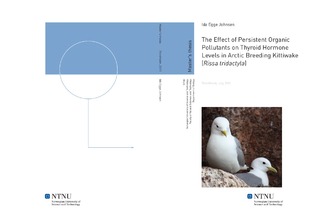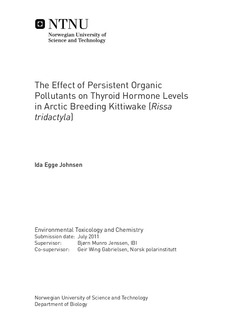| dc.description.abstract | Black-legged kittiwakes (Rissa tridactyla) breeding in the Arctic, are exposed to annual fluctuating environmental conditions. The impact of inter-year variations in environmental conditions on the blood concentrations of persistent organic pollutants (POPs) was examined in black-legged kittiwakes breeding in Kongsfjorden, Svalbard. In addition, it was examined if inter-year variations in concentration of POPs were affecting circulating thyroid hormone (TH) levels. Blood samples were collected from breeding kittiwakes during the incubation period in 2008 (n=46) and 2009 (n=31), two different years in respect of environmental conditions. The whole blood samples were analyzed for POPs: polychlorinated biphenyls (PCBs; PCB-28, -52, -99, -118, -101, -138, -153, 180, -183, -187, -194), hexachlorobezene (HCB), hexachlorocyclohexan (HCH), dichlorodiphenyltrichloroethane (p,p -DDT), dichlorodiphenyldichloroethylene (p,p -DDE) oxychlordane, cis-chlordane, trans-chlordane, cis-nonachlor, trans-nonachlor, heptachlor, heptachloroepoxid, and mirex, using gas chromatography mass spectrometry. Plasma was analysed for concentrations of total triiodothyronine (T3), using radioimmunoassay. Associations between variables of POPs and T3 were analysed using univariate statistics. Biometric measurements of the kittiwakes; body mass, skull length, and wing length where included in the statistical analysis, together with calculated BC (BC; body mass controlled for body size). Associations between the variables were analysed using multivariate statistics. The PCBs were the dominant contaminants in both 2008 and 2009. The three major constituents in the kittiwakes were PCB-153, followed by PCB-138 and PCB-180. Even though the body condition of the kittiwakes was significant poorer in 2009 compared to 2008, the concentrations of PCBs and DDE did not differ between 2008 and 2009. The concentration (ng/g wet weight [w.w.]) of HCB and oxychlordane were significant higher in 2009 compared to 2008. There was a strong negative association between HCB and body condition of the kittiwakes. Also the concentration of oxychlordane was negative correlated to body condition. Thus, kittiwakes with poor body condition had higher levels of HCB and oxychlordane. Additionally, HCB, oxychlordane and PCB-183 were positively associated with egg-laying date, while body condition was negatively correlated to egg-laying date. The results showed that kittiwakes with a poor body condition and thus, high levels of HCB and oxychlordane, were associated with late breeding. The low body condition in 2009 indicated poor food availability and unfavourable conditions for the kittiwakes that year. | nb_NO |

